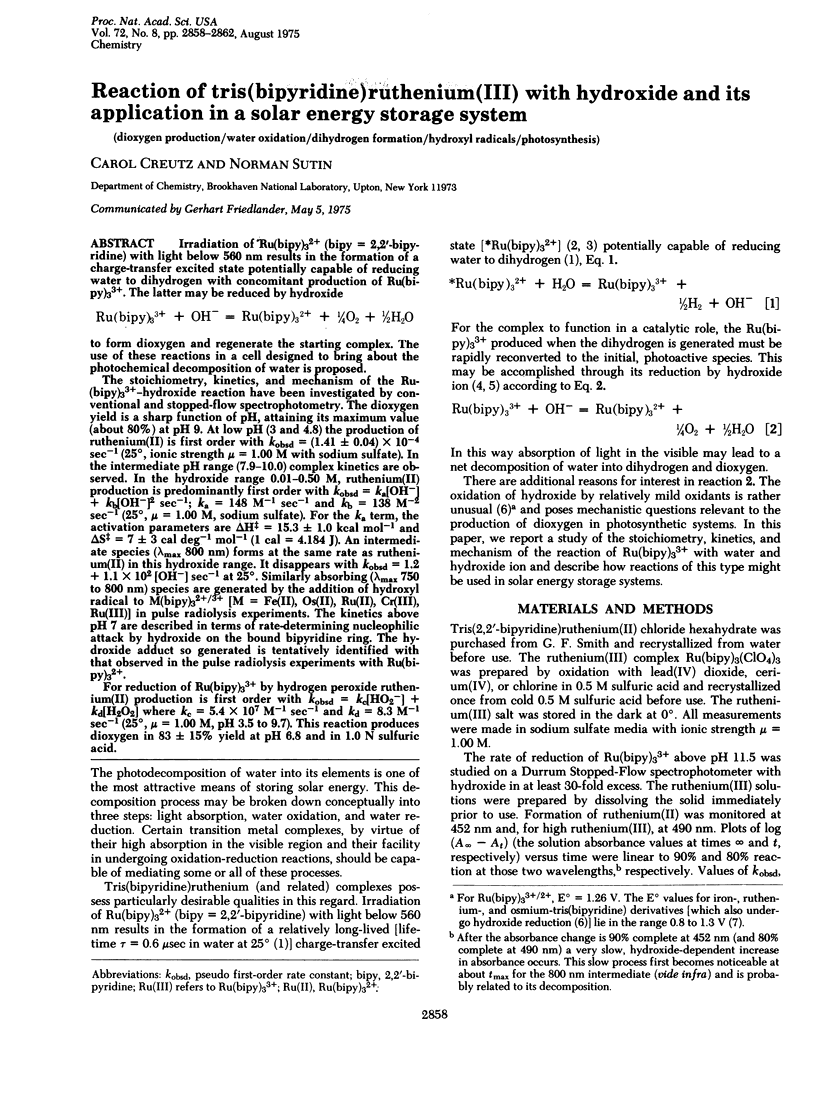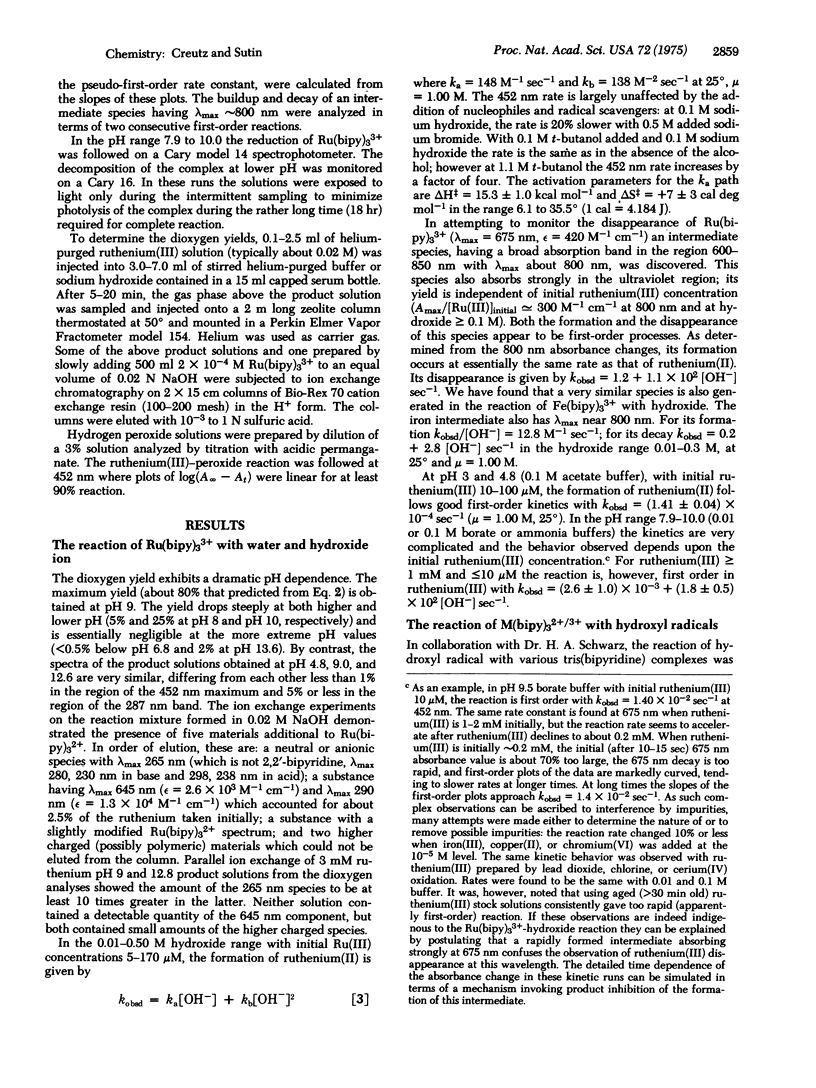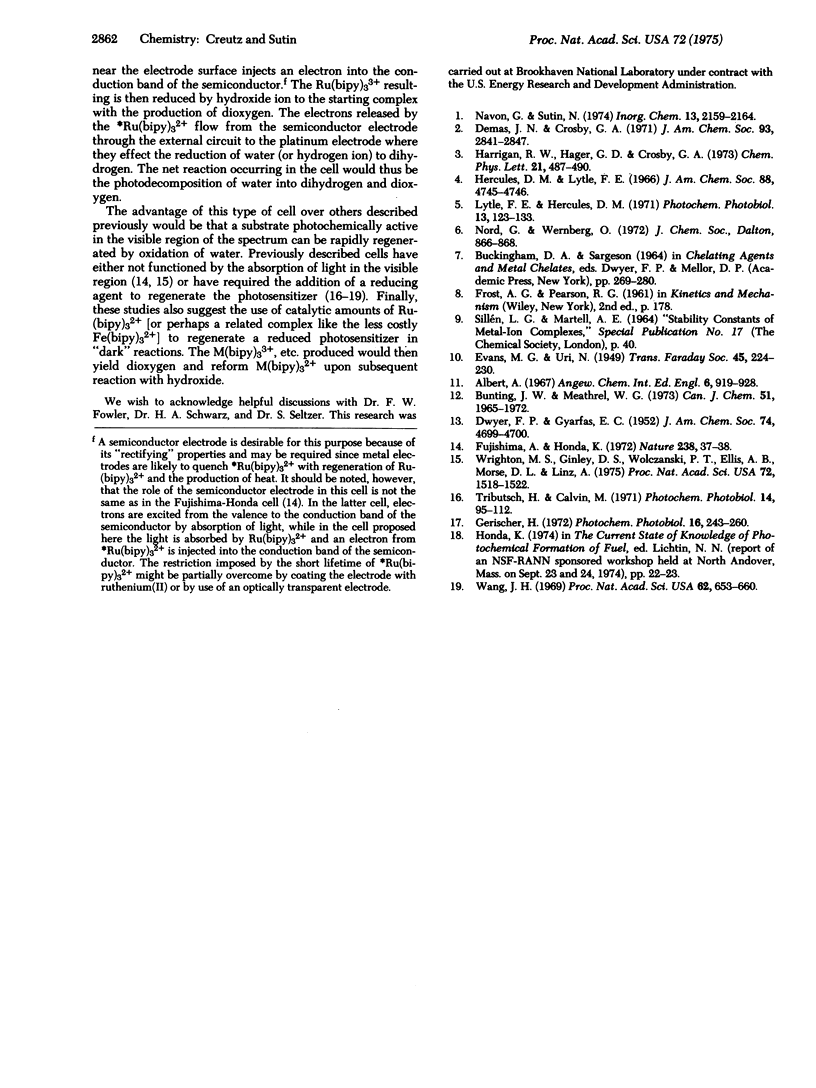Abstract
Irradiation of Ru(bipy)32+ (bipy = 2,2′-bipyridine) with light below 560 nm results in the formation of a charge-transfer excited state potentially capable of reducing water to dihydrogen with concomitant production of Ru(bipy)33+. The latter may be reduced by hydroxide [Formula: see text] to form dioxygen and regenerate the starting complex. The use of these reactions in a cell designed to bring about the photochemical decomposition of water is proposed.
The stoichiometry, kinetics, and mechanism of the Ru(bipy)33+-hydroxide reaction have been investigated by conventional and stopped-flow spectrophotometry. The dioxygen yield is a sharp function of pH, attaining its maximum value (about 80%) at pH 9. At low pH (3 and 4.8) the production of ruthenium(II) is first order with kobsd = (1.41 ± 0.04) × 10-4 sec-1 (25°, ionic strength μ = 1.00 M with sodium sulfate). In the intermediate pH range (7.9-10.0) complex kinetics are observed. In the hydroxide range 0.01-0.50 M, ruthenium(II) production is predominantly first order with kobsd = ka[OH-] + kb[OH-]2 sec-1; ka = 148 M-1 sec-1 and kb = 138 M-2 sec-1 (25°, μ = 1.00 M, sodium sulfate). For the ka term, the activation parameters are ΔH‡ = 15.3 ± 1.0 kcal mol-1 and ΔS‡ = 7 ± 3 cal deg-1 mol-1 (1 cal = 4.184 J). An intermediate species (λmax 800 nm) forms at the same rate as ruthenium(II) in this hydroxide range. It disappears with kobsd = 1.2 + 1.1 × 102 [OH-] sec-1 at 25°. Similarly absorbing (λmax 750 to 800 nm) species are generated by the addition of hydroxyl radical to M(bipy)32+/3+ [M = Fe(II), Os(II), Ru(II), Cr(III), Ru(III)] in pulse radiolysis experiments. The kinetics above pH 7 are described in terms of rate-determining nucleophilic attack by hydroxide on the bound bipyridine ring. The hydroxide adduct so generated is tentatively identified with that observed in the pulse radiolysis experiments with Ru(bipy)32+.
For reduction of Ru(bipy)33+ by hydrogen peroxide ruthenium(II) production is first order with kobsd = kc[HO2-] + kd[H2O2] where kc = 5.4 × 107 M-1 sec-1 and kd = 8.3 M-1 sec-1 (25°, μ = 1.00 M, pH 3.5 to 9.7). This reaction produces dioxygen in 83 ± 15% yield at pH 6.8 and in 1.0 N sulfuric acid.
Keywords: dioxygen production, water oxidation, dihydrogen formation, hydroxyl radicals, photosynthesis
Full text
PDF




Selected References
These references are in PubMed. This may not be the complete list of references from this article.
- Fujishima A., Honda K. Electrochemical photolysis of water at a semiconductor electrode. Nature. 1972 Jul 7;238(5358):37–38. doi: 10.1038/238037a0. [DOI] [PubMed] [Google Scholar]
- Wang J. H. Synthesis of amodel system for the primary energy conversion reactions in photosynthesis. Proc Natl Acad Sci U S A. 1969 Mar;62(3):653–660. doi: 10.1073/pnas.62.3.653. [DOI] [PMC free article] [PubMed] [Google Scholar]
- Wrighton M. S., Ginley D. S., Wolczanski P. T., Ellis A. B., Morse D. L., Linz A. Photoassisted electrolysis of water by irradiation of a titanium dioxide electrode. Proc Natl Acad Sci U S A. 1975 Apr;72(4):1518–1522. doi: 10.1073/pnas.72.4.1518. [DOI] [PMC free article] [PubMed] [Google Scholar]


